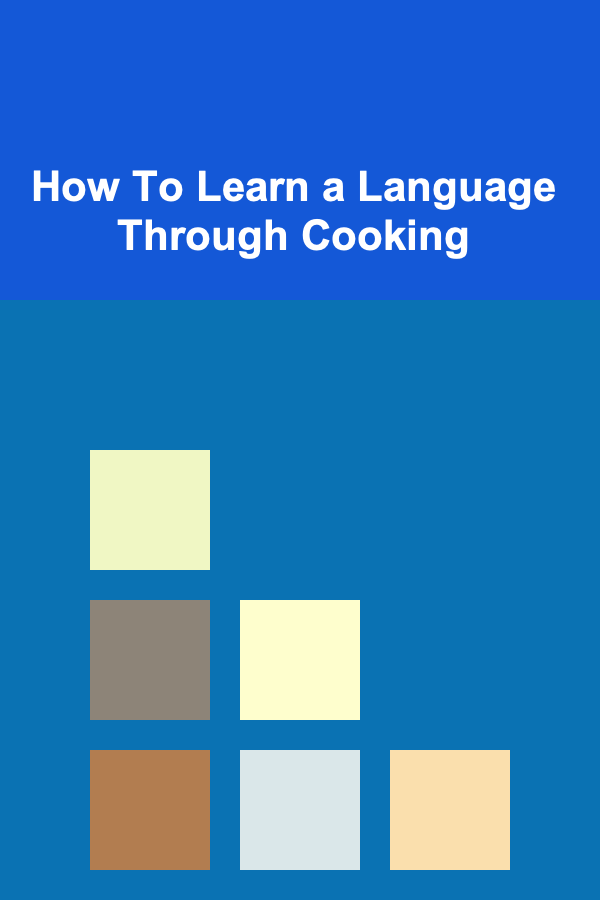
How To Learn a Language Through Cooking
ebook include PDF & Audio bundle (Micro Guide)
$12.99$9.99
Limited Time Offer! Order within the next:

Learning a new language can be an exciting yet daunting challenge, especially when you're trying to immerse yourself in a completely different linguistic world. Traditional methods like attending language classes, using apps, or reading books are useful, but what if you could integrate something more enjoyable and practical into your learning process? Enter the world of cooking.
Cooking is an activity that naturally engages multiple senses---sight, smell, taste, and touch. It's a deeply cultural experience, often tied to history, customs, and traditions. By using cooking as a medium to learn a language, you're not only connecting with the vocabulary and grammar of the language but also immersing yourself in the culture of the region or country where the language is spoken.
In this article, we'll explore how cooking can be an effective tool to learn a new language. From vocabulary acquisition to cultural understanding, we'll break down the benefits of learning a language through the culinary arts and provide tips and strategies to make the process both fun and educational.
Engaging the Senses for Better Retention
The key to retaining new information is engaging as many senses as possible. When you learn a language through cooking, you engage more than just your eyes and ears. The process involves your hands, your sense of taste, smell, and even the way your brain connects these sensory experiences with the new language.
Imagine you're making a French dish like Ratatouille. While chopping vegetables, you're not only learning the names of the ingredients in French, but you're also hearing how those words sound as you say them aloud. You might smell the herbs, touch the tomatoes, and feel the knife cutting through the zucchini. Each of these sensory experiences will help reinforce the language in your brain, as the act of cooking naturally intertwines with language acquisition.
This sensory involvement significantly boosts memory and understanding. Studies have shown that people tend to remember things better when they have experienced them through multiple senses. So, when you're learning words like "aubergine" (eggplant) or "courgette" (zucchini) while preparing a dish, you're creating deeper neural connections.
Building Vocabulary in Context
One of the major challenges in language learning is remembering new vocabulary and applying it in meaningful contexts. Cooking provides the perfect environment for this because it allows you to learn words that are related to tangible objects and actions.
Consider the process of preparing a simple dish like spaghetti. You'll learn words for ingredients like "tomato," "pasta," "onion," "garlic," and "basil," but also terms related to cooking actions such as "boiling," "sautéing," "chopping," "stirring," and "mixing." These words are not learned in isolation---they're practiced in the context of a real-life activity. This contextual learning makes it easier to remember and use the language.
In addition, recipes themselves are full of useful language. Whether you're following a written recipe or watching a video, you'll come across common phrases and commands, like "preheat the oven," "add salt to taste," or "cook for 10 minutes." These phrases are often repeated, reinforcing both the vocabulary and grammar structures you're learning.
Cultural Understanding Through Food
Language and culture are inseparable. A language is shaped by the history, traditions, and values of the people who speak it. When you cook a dish from a particular country or region, you're not just learning how to prepare food; you're diving deep into the cultural context that informs the language.
For instance, if you're learning Italian, cooking a traditional pasta dish like Cacio e Pepe gives you a glimpse into the simplicity and elegance of Italian cooking. As you learn the names of the ingredients and follow the recipe instructions, you're also uncovering a part of Italy's culinary history. Each region has its own specialties, ingredients, and cooking methods, which are often tied to the geography, climate, and customs of the area.
Understanding the cultural context of the language helps you communicate more authentically. When you understand the food customs of a country, you can engage in conversations with native speakers about food, dining etiquette, festivals, and traditions, all of which are key aspects of the language. Language, after all, is not just about words; it's about expressing the identity, customs, and values of a community.
Practical Steps to Learning a Language Through Cooking
Now that we've established the benefits of learning a language through cooking, let's dive into some practical steps you can take to make the most of this method.
4.1. Choose a Language and Cuisine
The first step is to decide which language you want to learn and choose the cuisine associated with that language. This doesn't mean you have to be an expert in the cuisine right away. The goal is to pick a language that excites you and a cuisine that you're passionate about.
For example, if you're interested in learning Spanish, you might explore traditional Spanish dishes like paella , tapas , or tortilla española . If you're leaning toward French, you could try making croissants , coq au vin , or ratatouille.
Selecting a cuisine you're enthusiastic about will keep you motivated throughout the learning process. The more you enjoy cooking the food, the more likely you'll stay engaged with the language.
4.2. Watch Cooking Videos in the Target Language
One of the best ways to get used to hearing the language in a cooking context is to watch recipe videos in the target language. YouTube is filled with cooking channels in different languages. Search for cooking tutorials in the language you're learning and watch them as you follow along with the recipe.
For example, if you're learning German, you might search for "German cooking recipes" or "Deutsche Rezepte." Watching a German chef explain how to make a dish while hearing the language will help you familiarize yourself with the vocabulary used in cooking. Over time, you'll begin to understand the language better and pick up pronunciation tips as well.
4.3. Practice Speaking Out Loud
While cooking, it's helpful to speak the language out loud. As you follow the recipe, narrate what you're doing in the target language. For example, as you chop onions, you can say, "I'm chopping the onions" or "I'm putting the onions in the pan." This simple practice will help reinforce the vocabulary and action verbs you're learning.
Additionally, you can practice ordering food in the language. Pretend you're at a restaurant, and say out loud, "I'd like to order a pizza" or "Please bring me the dessert." This active use of language can make the learning process more engaging.
4.4. Learn Cooking Terms and Commands
Many cooking terms are universal, but each language has its own set of specific terms that are crucial to mastering. As you cook, take the time to learn common cooking verbs and phrases. You can create flashcards or notes with the English translation on one side and the target language on the other.
Here are some examples of cooking terms and commands in different languages:
- English: Stir, chop, boil, fry, sauté
- French: Mélanger (stir), couper (chop), faire bouillir (boil), frire (fry), faire sauter (sauté)
- Spanish: Revolver (stir), cortar (chop), hervir (boil), freír (fry), saltear (sauté)
- Italian: Mescolare (stir), tagliare (chop), bollire (boil), friggere (fry), saltare (sauté)
As you encounter these words in the recipe or cooking videos, repeat them out loud. Eventually, you'll become more comfortable using these terms in conversations related to food.
4.5. Join Cooking Classes or Language Exchange Groups
If possible, take a cooking class in the language you're learning. Many cities offer cooking classes that are taught in foreign languages, particularly in larger cultural hubs. These classes often include practical hands-on cooking along with language immersion.
Alternatively, you could find a language exchange partner who loves cooking. Organize a cooking session where you both cook a dish in the target language, teaching each other new words and phrases related to food preparation.
The Long-Term Benefits of Language Learning Through Cooking
Using cooking as a tool to learn a language isn't just about learning vocabulary. It's about creating a deeper connection with the culture, improving memory retention, and making language acquisition fun. Over time, you will find yourself gaining confidence in both your language skills and your cooking abilities.
- Increased Motivation: Cooking is an enjoyable and practical activity, making the learning process more enjoyable. You won't dread studying because you're connecting with the language in a meaningful and enjoyable way.
- Deeper Cultural Understanding: As you cook dishes from different countries, you gain a deeper understanding of the culture and the people who speak the language. This not only enriches your learning experience but also opens doors for more meaningful communication.
- Enhanced Communication Skills: The more you practice speaking and listening while cooking, the more your communication skills will improve. You'll be more comfortable using the language in everyday situations, whether it's ordering food at a restaurant or discussing your favorite recipes.
Conclusion
Learning a language through cooking is an effective, immersive, and enjoyable method that engages your senses and enhances vocabulary retention. It combines the joy of creating delicious food with the challenge of mastering a new language, making the entire process more engaging and rewarding. By incorporating language learning into your cooking routine, you'll not only acquire new skills in the kitchen but also enrich your understanding of the culture behind the language. So, roll up your sleeves, grab your apron, and start cooking your way to language proficiency.

How to Manage Pet Waste Effectively in Your Home
Read More
How To Create a Knowledge Base for Remote Teams
Read More
How to Design a Cleaning Schedule Planner for Small Apartments
Read More
How to Build Rapport with Patients: A PTA's Guide
Read More
How to Build a Custom Inventory Management System with Open Source Tools
Read More
10 Common Retirement Plan Fees and How to Avoid Them
Read MoreOther Products

How to Manage Pet Waste Effectively in Your Home
Read More
How To Create a Knowledge Base for Remote Teams
Read More
How to Design a Cleaning Schedule Planner for Small Apartments
Read More
How to Build Rapport with Patients: A PTA's Guide
Read More
How to Build a Custom Inventory Management System with Open Source Tools
Read More